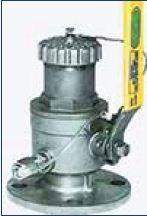201419 H2S- Dangerous at almost any concentration
Edited from US Coast Guard Marine Safety Alert 02-14
During a recent Port State Control (PSC) tank vessel examination it was requested that cargo tank oxygen levels be verified using the ship’s portable gas meter. The vessel was carrying Grade E Sour Crude. When the deck sounding valve (see photo) was opened, the pressurised cargo tank atmosphere escaped releasing inert gas and H2S (hydrogen sulphide) vapours. During the evolution the personal gas meters of two individuals alarmed for H2S. One whose alarm sounded was standing 1-2 feet downwind from the sounding valve.

Within days, this person developed severe exposure symptoms consistent with H2S exposure. Two others involved were standing upwind. Afterward, one reported experiencing a minor headache.
H2S is a colourless, flammable gas with a ‘rotten egg’ smell that occurs naturally in crude petroleum. Even at low concentrations this heavier-than- air gas can irritate the eyes, nose, throat and respiratory system with effects delayed for hours or days. At higher concentrations, nausea, vomiting, headaches, dizziness, unconsciousness or death may occur. While the initial ‘rotten egg’ odour is present, an individual may lose the ability to smell that gas after becoming exposed. Personal monitoring equipment is, therefore, vital to protect against exposure.
An alarm on H2S constitutes an acute exposure and should trigger immediate evacuation and initiation of acute exposure procedures including medical attention.
The International Oil Tanker and Terminal Safety Guide (ISGOTT) recommends that personnel should stand perpendicular to the wind when sampling tanks, in order to avoid being downwind or upwind and creating eddies. When monitoring cargo tank atmospheres, all personnel should exercise diligence and great care. In all cases, personnel should completely assess the risks including the cargo type, tank pressure, venting arrangements, wind direction/speed and condition of the testing equipment. When H2S is suspected, ISGOTT recommends that self-contained breathing apparatus (SCBA) be worn if it is necessary to breach the integrity of the cargo system and if a vapour free atmosphere cannot be guaranteed.
Additionally, the American Conference of Governmental Industrial Hygienists recently reduced the H2S dangerous Threshold Limit Value from two parts per million (ppm) to one ppm.
